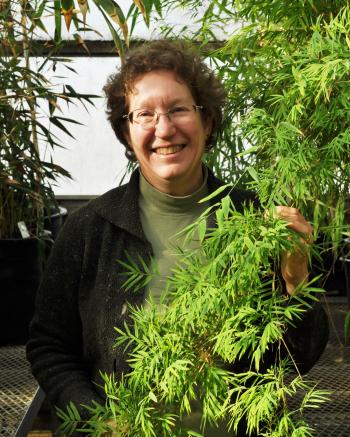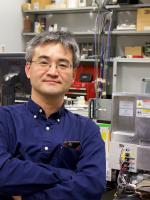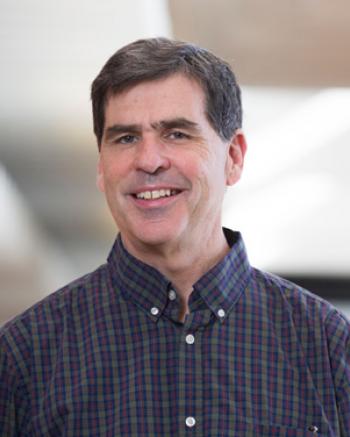Faculty Partners
INSPIRATIONAL PARTNERSHIPS
BOEC Partners
The Biotechnology Outreach Education Center (BOEC) is based at Iowa State University and supports the work of the Office of Biotechnology. At the core of our work are healthy and inspirational partnerships. Through equitable collaboration, diverse perspectives, and bias-free learning communities, we work to fulfill our mission.
The BOEC benefits from active partnerships with many institutions and individuals – both on campus and elsewhere. Here are some thoughts from and about several of our current partners.

Chemurgy
Laura Jarboe, Director
The goal of the Chemurgy 2.0 project is to position Iowa as a leading force in advanced biomanufacturing by revitalizing the concept of “chemurgy” – applied chemistry centered on the production of industrial goods from agricultural resources.
Chemurgy 2.0 focuses on manufacturing proteins, vaccines, and therapeutics; manufacturing biochemicals and bio fibers; 3D-printing and composite fabrication processes that utilize biochemicals and fibers; and applications of data science and artificial intelligence. This initiative aims to enhance research infrastructure at Iowa’s research universities and predominantly undergraduate institutions in the state. Additionally, the project extends research experiences and educational opportunities to pre-service teachers and undergraduates, emphasizing inclusivity by reaching out to traditionally underrepresented groups, such as first-generation and rural undergraduate students.

REGENPGC
Raj Raman, Director
RegenPGC stands for Regenerating America’s Working Landscapes to Enhance Natural Resources and Public Goods through Perennial Groundcover. We are a transdisciplinary team of scientists and engineers, funded by USDA-NIFA, with a shared vision of making year-round groundcover on working lands the norm, rather than the exception, for Midwestern US agriculture and beyond.

Dean Adams
Department of Ecology, Evolution & organismal biology
Our research focuses on the macroevolution of multivariate phenotypes. We develop new analytical tools for quantifying multivariate phenotypes (geometric morphometrics), new statistical permutation approaches for high-dimensional data, and new phylogenetic comparative methods for multivariate phenotypes. His empirical work focuses largely on morphological evolution in vertebrates.

Alicia Carriquiry
Center for Statistics and Applications in Forensic Evidence (CSAFE)
Our research focuses on applications of statistics in human nutrition, bioinformatics, forensic sciences, and traffic safety. Current research focuses on digital evidence, growing in importance as digital devices become ubiquitous in modern society. This type of evidence poses unique challenges, from recovering illicit data or software hidden on phones and tablets to examining digital traces of user activity (e.g., messages/texts, login events) for signs of criminal activity. CSAFE research addresses the increased demand for digital forensics tools and methods built on strong probabilistic and statistics foundations.

Lynn Clark
Department of Ecology, Evolution, and Organismal Biology
My research program involves four main lines of investigation: 1) bamboo systematics and evolution based on both morphological and molecular data; 2) floristic inventory and monography of Neotropical bamboos; 3) the evolution and development of vegetative features (e.g., leaf shape and 3-D leaf anatomy) within the grass family; and 4) functional trait ecology and evolution in fire-adapted Neotropical bamboos.

Shui-zhang Fei
Department of Horticulture
Our research focuses on the use of genetics and molecular tools to study mechanisms that control the development of key agronomic traits such as tolerance to abiotic stresses in economically important grasses including perennial ryegrass, creeping bentgrass, switchgrass and the model grass, Brachypodium.

Corrinne Grover
DEPARTMENT OF ECOLOGY, EVOLUTION & ORGANISMAL BIOLOGY
My primary focus is on understanding how genomes evolve, specifically the short- and long-term consequences of genome duplication on the genome and transcriptome, both broadly speaking and in the context of gene networks.

Larry Halverson
Department of Plant Pathology, Entomology and Microbiology
Our research focuses on discovering how bacteria live and interact with each other in a community. This information is important for understanding how bacterial communities interact with plants to promote growth of healthy plants and to reduce nitrogen fertilizer use.

Adina Howe
Agricultural and biosystems engineering
Adina Howe’s research integrates molecular and computational biology to study, model, and manage complex microbial systems in both natural and engineered environments.

Matthew Hufford
Department of Ecology, Evolution & organismal biology
Our research focuses on the demography and local adaptation of ancient farmer varieties of maize known as “landraces”, the evolutionary significance of gene flow across taxa in the genus Zea, and genome assembly and comparative genomics of maize, teosinte and grass species in the Andropogoneae tribe.

Amy Kaleita
AGRICULTURE & BIOSYSTEMS ENGINEERING
Dr. Kaleita’s research focuses on information technology for precision conservation. Primary interests are remote sensing, crop and hydrologic modeling, precision farming, and advanced analytical methods for understanding the influence of spatiotemporally variable soil and hydrologic properties.

Dior Kelley
Department of Genetics, Development and cell biology
Our research explores how auxin signaling modules control diverse developmental processes in Arabidopsis. I am applying a variety of molecular approaches to these studies, including RNA-seq, Ribo-seq, proteomics, and phenotyping. Such multi-scale integration will elucidate new aspects of auxin biology, including links between different aspects of gene regulation and identify novel regulators of plant development.

Young-Jin Lee
Chemistry
The Lee group has interests in developing new mass spectrometry techniques and applying to solve science and engineering problems. The two current major focus areas are mass spectrometry imaging in single cell or subcellular level high-spatial resolution, and understanding complex bio-oils produced through thermochemical conversion.

Sara Lira
Corteva Agriscience
Dr. Lira’s research focuses on breeding for emerging climate-positive cropping systems. Her work has lately emphasized the development of cropping systems, including annual and perennial cover crops and double crops for the Midwest.

Thomas Lübberstedt
Department of Agronomy
Our focus is on identifying superior groundcover and corn germplasm and determining the functional traits related to their compatibility. This work will optimize PGC cropping systems by screening for superior groundcovers and maize hybrids that minimize competition between species. We can help enhance PGC’s economic viability through yield improvement and reduced management requirements while increasing ecosystem impacts via reduced chemical inputs. Our work will also enable the design of novel breeding strategies and provides the opportunity to establish dedicated breeding programs for PGC hybrids and varieties.

Gustavo Macintosh
Biochemistry, Biophysics, and Molecular Biology
Our lab works on a variety of things, mostly centered around the two big questions, how do eukaryotic cells recycle ribosomes, and what are the molecular bases of compatible and incompatible interactions between plants and insects? Gustavo also dedicates a significant effort to increase equity and inclusion in STEM. I consider this aspect of my profession on par with scholarly work and teaching and not a side project that can be relegated to a minor role.

Marshall McDaniel
Department of Agronomy
Research in the McDaniel Lab focuses on both sides of the “give-and-take” relationship between soils and plants, and how land management or global change (like climate change) might affect this relationship. Much of the research in the McDaniel Lab is based in soil biology since soil fauna and microbes are crucial at both the give and take stages, as they are largely responsible for creating new soil organic matter and making nutrients available to plants. In agroecosystems, much of the limitations in crop production and environmental issues are caused when this give-and-take relationship is out of balance. Research from the McDaniel Lab informs agricultural management that helps to balance this relationship. Management practices like crop rotations, cover cropping, no-till (or reduced tillage), and increased residue all can enhance soil-plant synergy. That is because they not only benefit the crops in the field, but also enhance soil health and increase sustainability. When we get this soil-plant synergy on the farm, we also find that the environmental impacts of agriculture are also often reduced – like soil greenhouse gas emissions and nutrients lost to waterways.

James Michael
Department of Mechanical Engineering
The multiphase reacting flow laboratory uses optical and spectroscopic techniques to investigate energy-harnessing systems, including liquid sprays, detonation, and other propulsion systems. Our work is multidisciplinary – combining physics (optics), chemistry, and engineering approaches to understand the underlying mechanisms as energy (temperature) moves through these systems.

Ken Moore
Department of Agronomy
Dr. Moore’s research focuses on the production and utilization of perennial crops. His current research emphasizes evaluation of alternative biomass crop species, development of biomass cropping systems, and post-harvest storage and pretreatment strategies. He has conducted several experiments to determine relationships between the structure of plant cell walls and their bioavailability through enzymatic hydrolysis. Research accomplishments in this area include characterization of the structure and digestion kinetics of cell walls in normal and brown midrib sorghums, contrasting genotypes of switchgrass, indiangrass, big bluestem and several Brachiaria species.

Raj Raman
Department of agricultural and biosystems engineering
Dr. Raman is teaming with colleagues to develop crop production systems that conserve soil, improve water quality, while increasing producer income. These goals – which have often been found to be conflicting with one another – could be achieved by combining perennial ground covers with conventional row crops – thereby sidestepping bare-earth methods and shifting large-scale ag production toward a more sustainable approach.

Zengyi Shao
Chemical & Biological Engineering
The advent of synthetic biology has revolutionized our ability to understand molecular mechanisms in complex biological processes, re-program genetic coding, and create novel functions. The long-term goal of the Shao Lab is to elucidate the ‘functional genomics’ of high-performing microbial species that have unique biochemical, metabolic, and physiological features. We strive for developing platform technologies to provide generalizable strain-engineering solutions, enabling rapid, functional modifications of high-performance microbes, and expanding the current collection of microbial factories.

Michelle Soupir
Agriculture & Biosystems Engineering
Dr. Soupir is concerned about the health of our environment. Since beginning her work at ISU in 2008, she and those working in her lab have studied various aspects of local watersheds and water quality. The Soupir lab has a passion for learning about the existing threats to local bodies of water and what we can do to mitigate potentially harmful situations.
Some of their studies focus on using innovative strategies to remove nitrates from field runoff water. These investigations often employ ‘woodchip bioreactors’ to house nitrogen-removing bacteria that lower nitrate levels before the runoff joins other bodies of water. Dr. Soupir uses lab- and field-based research projects to monitor the occurrence, fate, and movement of nutrients and microorganisms in surface and drainage water.

Jeanne Serb
Ecology, Evolution, and Organismal Biology
My research examines how biological diversity originates and is maintained through the interactions of multiple levels of biological organization, mainly how selection influences the creation and recreation of specific phenotypes, such as eyes. Eyes have evolved over fifty times in animals and encompass a great diversity of forms. Despite the many different eye types of animals, from jellyfish to humans, the proteins that transform light into a chemical signal or ‘light sensing machinery’ are similar across eyes. Learning about the genetic processes that drive the conversion of a n-visual structure to an eye is essential to understanding how organisms can re-purpose genetic material to give rise to a new organ and adapt to changing environments.

Amy toth
Department of Ecology, Evolution & organismal biology
Amy is interested in the mechanisms and evolution of insect sociality, using paper wasps and honey bees as model systems. Current research projects involve de novo sequencing of paper wasp genomes and transcriptomes, comparative genomic analysis of Hymenoptera, genomic and epigenetic mechanisms regulating caste evolution, and the influences of nutrition and viruses on honey bee behavior and health.

Eric Underbakke
Department of Biochemistry, Biophysics And Molecular Biology
Our lab employs mass spectrometry and chemical tools to probe the interactions and post-translational modifications that contribute to synaptic signaling strength and plasticity. Among these techniques, we use hydrogen-deuterium exchange mass spectrometry (HDX-MS) to map protein-protein interactions and conformational changes in dynamic signaling complexes. In addition, we employ diverse chemical tools for probing protein-protein interactions, such as crosslinkers, artificial amino acids, and spectroscopic tags. By integrating maps of protein interaction surfaces with the structures of the protein components, we can devise models of the higher-order architecture of the signaling assemblies. Furthermore, we can test how post-translational modifications and conformational changes remodel the architecture. Our targets of inquiry include kinases, trafficking chaperones, nitric oxide signaling components, and the scaffolding proteins that assemble these diverse signaling effectors together at the synaptic membrane.

Nicole Valenzuela
Department of Ecology, Evolution & organismal biology
My lab is broadly interested in understanding how ecology affects the structure, function, and evolution of the genome, and its role in the development and evolution of complex phenotypes, particularly the sexual phenotype. This helps us understand the evolution of biological diversity and how it responds to environmental change. My work integrates classic ecology, eco-genomics, phylo-genomics, and epigenetics, to understand the diversity of mechanisms by which males and females develop in different lineages, an outstanding biological question that remains unresolved. My research focuses on vertebrates, with turtles as a study system. My lab also develops genomic resources for the scientific community.

Xinwei Wang
Mechanical Engineering – Micro/Nanoscale Thermal Science Laboratory
The last 50 years have witnessed the transformation of solidstate devices from objects of mere scientific curiosity to being at the heart of information technology. Electronic and optoelectronic devices are now so ubiquitous in modern society that their use often goes unnoticed. One of the main factors that has enabled this dramatic transformation is the ability to control the flow of charge in semiconductors. While charge flows only in metals and semiconductors, heat on the other hand flows in all materials. It is, therefore, natural to ask the question: What are the fundamental and engineering limits on the control of heat flow in solids? In our lab, we focus on the TET technique, and thermal diffusivity of micro fibers.

Jonathan Wendel
Ecology, Evolution, and Organismal Biology
Our research focuses on mechanisms underlying the means by which flowering plant genomes and phenotypes diversify, with a special focus on the phenomenon of genome doubling, or polyploidy using the cotton genus (Gossypium), in which two diploid and two polyploid species were each independently domesticated thousands of years ago. This nature evolutionary and early human history provide a model framework for exploring the comparative basis of domestication, the origin of form and of diversity in nature, and the evolutionary consequences of genome doubling.

Roger Wise
Plant Pathology & Microbiology
Research in the Wise laboratory is focused on the high-throughput functional analysis of important agronomic genes in cereal crops. We use a variety of interdisciplinary approaches, including plant and microbial genetics, molecular biology, plant pathology, and bioinformatics & computational biology. THE OVER-ARCHING QUESTIONS WE SEEK TO ADDRESS ARE: How does the host regulate immune signaling networks in response to pathogen attack? What mechanisms do pathogens employ to reprogram host cellular processes to favor disease progression at different stages of infection?

Yanhai Yin
Genetics, Development, and Cell Biology
My laboratory is interested in understanding the molecular mechanisms and gene regulatory networks through which plant steroid hormone, Brassinosteroid (BRs), regulate plant growth and stress responses. We use a combination of genetics, genomics, computational modeling and predicative phenomics approaches and model plant Arabidopsis thaliana in our research. Our long-term goal is to apply the knowledge generated from model systems to improve crop production under adverse climate conditions.

Olga Zabotina
Department of Biochemistry, biophysics and molecular biology
Our lab is interested in understanding the molecular mechanisms of polysaccharide biosynthesis in Golgi. We utilize a broad range of approaches, including reverse-genetics, cellular, molecular, and structural biology, and biochemistry and a wide array of cells, including mammalian, plant, yeast and bacteria. Specifically, we investigate the functional organization of the large Golgi localized multiprotein complex involved in biosynthesis of xyloglucan, a highly branched polysaccharide in plant cells.
